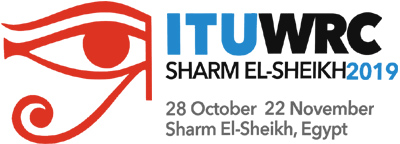 Though it may have passed most of the international news channels by, the world's radio spectrum regulators and associated government departments and ministers have just signed away the results of the 2019 World Radiocomminication Conference (WRC-19) held in Sharm El Sheikh, Egypt. This 4 week long event is where international decisions on the use of the radio spectrum take place. Or at least that's the theory. All 'decisions' have to be driven by consensus, which means that everyone must agree and with so many divergent views on topics as wide ranging as more spectrum for 5G mobile services, to globally harmonising spectrum for railway communications, there is lots to discuss. There were around 20 items on the agenda for the conference.
Though it may have passed most of the international news channels by, the world's radio spectrum regulators and associated government departments and ministers have just signed away the results of the 2019 World Radiocomminication Conference (WRC-19) held in Sharm El Sheikh, Egypt. This 4 week long event is where international decisions on the use of the radio spectrum take place. Or at least that's the theory. All 'decisions' have to be driven by consensus, which means that everyone must agree and with so many divergent views on topics as wide ranging as more spectrum for 5G mobile services, to globally harmonising spectrum for railway communications, there is lots to discuss. There were around 20 items on the agenda for the conference.Of particular interest to radio amateurs was agenda item 1.1, which concerned:
the allocation of the frequency band 50-54 MHz to the amateur service in Region 1
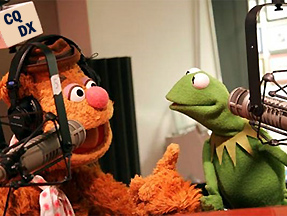 Radio amateurs have requested that the whole frequency range from 50 to 54 MHz is allocated to them on a primary basis in ITU Region 1 which is Europe, the Middle East and Africa. At present, in the ITU Radio Regulations, which dictate which frequencies are allocated to which services, 50 - 54 MHz is allocated to radio amateurs on a primary basis in Regions 2 (the Americas) and 3 (Asia/Pacific), and the idea was to align the band in every region. In Region 1 the frequencies are allocated to broadcasting as well as (in some countries) to radiolocation, land mobile and fixed (point-to-point) services, but not to radio amateurs (unless national administrations have unilaterally decided to allow them). Only in Botswana, Eswatini, Lesotho, Malawi, Namibia, the Democratic Republic of Congo, Rwanda, South Africa, Zambia and Zimbabwe does the band have any allocation to radio amateurs in the existing Radio Regulations.
Radio amateurs have requested that the whole frequency range from 50 to 54 MHz is allocated to them on a primary basis in ITU Region 1 which is Europe, the Middle East and Africa. At present, in the ITU Radio Regulations, which dictate which frequencies are allocated to which services, 50 - 54 MHz is allocated to radio amateurs on a primary basis in Regions 2 (the Americas) and 3 (Asia/Pacific), and the idea was to align the band in every region. In Region 1 the frequencies are allocated to broadcasting as well as (in some countries) to radiolocation, land mobile and fixed (point-to-point) services, but not to radio amateurs (unless national administrations have unilaterally decided to allow them). Only in Botswana, Eswatini, Lesotho, Malawi, Namibia, the Democratic Republic of Congo, Rwanda, South Africa, Zambia and Zimbabwe does the band have any allocation to radio amateurs in the existing Radio Regulations.Following the machinations at WRC-19, the radio amateurs have been granted a secondary allocation across Region 1 in the frequency range 50 - 52 MHz, with primary allocations in some or all of the range 50 - 54 MHz in a limited number of new countries. A secondary allocation means that the amateurs must not cause interference to any primary services (i.e. broadcasting and land mobile) and must accept interference from them, but it's a step forwards towards a global expansion of the 6 metre band.
This does not mean that the band will be available in each and every country immediately. First, each country's administration or regulator needs to update their national frequency allocation table to include the new band. This can take anything from a few months to a few years. There are still some countries who have not yet implemented the results of the previous WRC in 2015, despite it being completed 4 years ago. So don't hold your breath hoping to use the band when on holiday in Ouagadougou, it may be a long time before this new band is widely available.
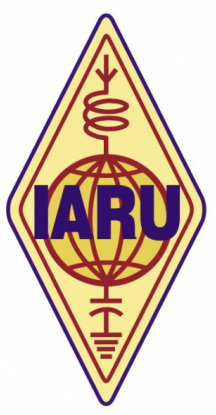 The next task for the International Amateur Radio Union (IARU) who work tirelessly on behalf of radio amateurs at events such as WRC-19 is to deal with Agenda Items 1.2 and 9.1.2 of the next WRC in 2023. Agenda Item 1.2 is entitled:
The next task for the International Amateur Radio Union (IARU) who work tirelessly on behalf of radio amateurs at events such as WRC-19 is to deal with Agenda Items 1.2 and 9.1.2 of the next WRC in 2023. Agenda Item 1.2 is entitled:to consider identification of the frequency bands ... 10.0-10.5 GHz for International Mobile Telecommunications (IMT), including possible additional allocations to the mobile service on a primary basis... (N.B. this applies in Region 2, i.e. the Americas, only)
This includes a secondary Amateur allocation between 10.0 and 10.5 GHz, and a secondary Amateur-Satellite allocation between 10.45 and 10.5 GHz (as used by the already infamous Es'Hail-2 (a.k.a. QO-100), the first geostationary satellite with an Amateur radio transponder. Whilst the allocation of the band for IMT (5G) services does not preclude the Amateur service, in reality, a band full of a dense network of base stations and handsets would make it nigh-on impossible to be used for amateur radio and the band may be lost, in exactly the same way that the 2.3 GHz and 3.4 GHz bands were.
Agenda Item 9.1.2 is entitled:
Review of the amateur service and the amateur-satellite service allocations in the frequency band 1 240-1 300 MHz to determine if additional measures are required to ensure protection of the radionavigation-satellite (space-to-Earth) service operating in the same band...
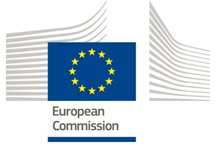 The IARU will need to stave off pressure to remove (or otherwise reduce) the radio amateur secondary allocation on the frequencies 1240 - 1300 MHz (the 23 cm band) as it is claimed by the European Commission that amateurs may cause interference to their Galileo satellte navigation system. Not, it is worth pointing out, the everyday service used by smart phones and in-car sat-navs, but an additional service for specialist users.
The IARU will need to stave off pressure to remove (or otherwise reduce) the radio amateur secondary allocation on the frequencies 1240 - 1300 MHz (the 23 cm band) as it is claimed by the European Commission that amateurs may cause interference to their Galileo satellte navigation system. Not, it is worth pointing out, the everyday service used by smart phones and in-car sat-navs, but an additional service for specialist users. 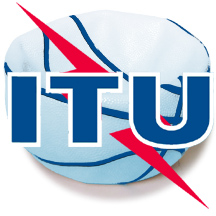 The argument goes that there was once an amateur television repeater in the band which caused interference. Once - and it was resolved very quickly. But that is enough to raise concerns of potential wider future interference problems. The Commission therefore want to throw the amateurs out of the spectrum. The amateur allocation is secondary, so they must not cause interference, and so the Galileo service is already protected, but that is not always enough for everyone. The ITU giveth with one hand, and threaten to take away with two others. Was it ever any different?
The argument goes that there was once an amateur television repeater in the band which caused interference. Once - and it was resolved very quickly. But that is enough to raise concerns of potential wider future interference problems. The Commission therefore want to throw the amateurs out of the spectrum. The amateur allocation is secondary, so they must not cause interference, and so the Galileo service is already protected, but that is not always enough for everyone. The ITU giveth with one hand, and threaten to take away with two others. Was it ever any different?add comment
( 1262 views )
| permalink
| 



 ( 3 / 21100 )
( 3 / 21100 )




 ( 3 / 21100 )
( 3 / 21100 )
Friday 15 November, 2019, 06:15 - Spectrum Management, Much Ado About Nothing
Posted by Administrator
Posted by Administrator
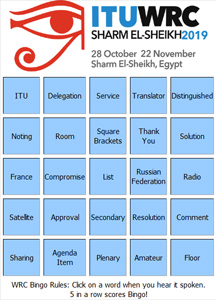 Over 1000 delegates are currently slogging it out at the World Radiocomminication Conference taking place in Sharm El Sheikh, Egypt. The conference can be extremely tedious as various working groups sit in laborious meetings working out whether 'and' or 'or' should be used in a sentence.
Over 1000 delegates are currently slogging it out at the World Radiocomminication Conference taking place in Sharm El Sheikh, Egypt. The conference can be extremely tedious as various working groups sit in laborious meetings working out whether 'and' or 'or' should be used in a sentence.To try and help with the boredom, Wireless Waffle presents, ITU WRC Bingo.
The rules are very simple. Whilst sitting in a meeting, every time that a word on your bingo card is spoken, click on it and it will be illuminated. If you get 5 words in a row (vertically, horizontally, or diagonally) you have achieved BINGO! At this point, the rules require you to stand up and shout either 'bingo' or 'house' but perhaps you might wish, instead, to ask the chairman for the floor and quietly state:
Subject to confirmation by the sub-working group, and noting the necessary primary resolution, I resolve to believe that the correct terminology for that which is in front of me, is 'Bingo'!
A lot of countries are beginning to consider the use of what is known as 'C-band' for new 5G services. The C-band runs from 3400 - 4200 MHz and is a set of radio frequencies extensively used for satellite connections (and for some point-to-point fixed links and the odd point-to-multipoint network). The satellite uses connections fall into a number of categories:
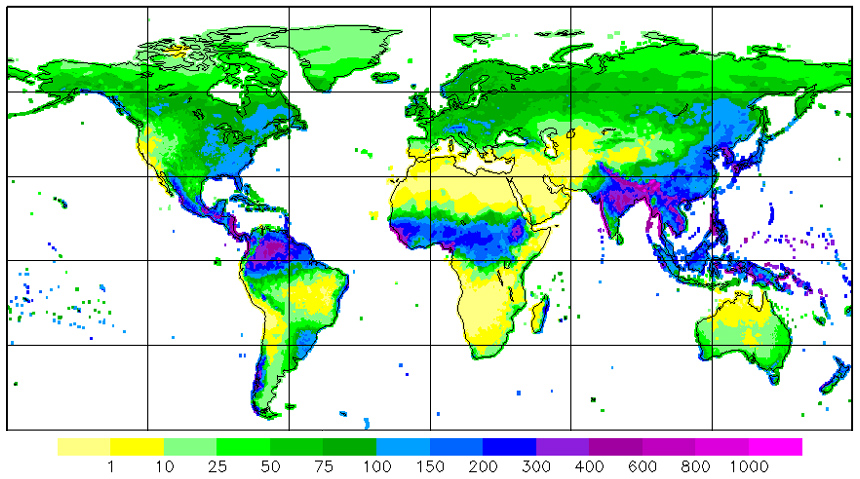
As can be seen from the map above (click for a bigger version), there is a swathe of the world, primarily in equatorial areas, where it really rains (those in blue and purple). In these areas, signals in other satellite frequency bands, such as Ku-band (11 GHz) and Ka-band (20 GHz) are absorbed so much by rain that when it pours, they become unreceivable but C-band being a lower frequency (4 GHz) does not. Using the band for 5G in countries where C-band is only lightly used is not impossible. Though 5G transmissions can wipe-out satellite reception in areas hundreds of kilometers from the 5G base stations, very careful planning of frequencies and site placements can lead to some solutions.
In countries, however, where there are hundreds of VSAT terminals, or thousands of domestic satellite receivers, the situation is more bleak. There is fundamentally no way that 5G networks and satellite receivers can share the same frequencies. The transmitter power of a satellite is not completely dissimilar to that of a 5G base station, but one is 40,000 kilometers away and the other may be 40 metres away. Clearly one will enormously overshadow the other.
The only way that the two services can therefore co-exist is to separate the 5G frequencies from those used for satellite reception.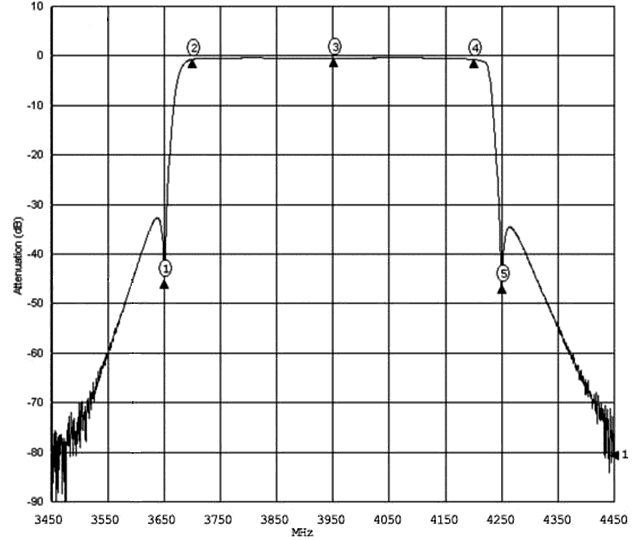 As there are no 'unused' satellite frequencies in the C-band, this means that regulators have to take a decision to slice up the band, taking spectrum away from satellites and giving it to 5G services and this is what many have done. Hong Kong, Cambodia, Singapore and the Philippines (to mention a few) have decided to use frequencies from 3400 - 3600 MHz for 5G services, and leave 3700 - 4200 MHz for satellite services. The gap in-between (3600 - 3700 MHz) is left as a guard-band, a kind of no-mans-land in which neither service has priority. This allows satellite receivers to be fitted with filters which allow signals above 3700 MHz through, whilst rejecting signals below 3600 MHz (see the example on the right).
As there are no 'unused' satellite frequencies in the C-band, this means that regulators have to take a decision to slice up the band, taking spectrum away from satellites and giving it to 5G services and this is what many have done. Hong Kong, Cambodia, Singapore and the Philippines (to mention a few) have decided to use frequencies from 3400 - 3600 MHz for 5G services, and leave 3700 - 4200 MHz for satellite services. The gap in-between (3600 - 3700 MHz) is left as a guard-band, a kind of no-mans-land in which neither service has priority. This allows satellite receivers to be fitted with filters which allow signals above 3700 MHz through, whilst rejecting signals below 3600 MHz (see the example on the right).
In such a scenario, there is still potential for interference to the satellite services in two possible ways:
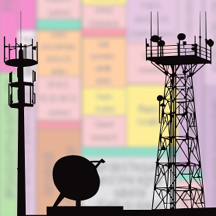 The solution to this, would be to fit filters to the 5G transmitters to reduce the unwanted emissions, but this costs the mobile operators and they are not keen to do so. In some cases they are not even able to do so. The use of 'massive MIMO' antennas means that the transmitters and antennas are incorporated into a single unit, inside which there is no room to fit a filter.
The solution to this, would be to fit filters to the 5G transmitters to reduce the unwanted emissions, but this costs the mobile operators and they are not keen to do so. In some cases they are not even able to do so. The use of 'massive MIMO' antennas means that the transmitters and antennas are incorporated into a single unit, inside which there is no room to fit a filter.
Sharing of the C-band between satellite services and 5G networks therefore remains a thorny issue and it will be interesting to see how the problem is resolved. One option is, of course, to use a different band in areas where C-band satellite is in strong demand. The 2.6 GHz band (2500 - 2690 MHz) is currently built in to every 5G phone that is on the market and in the near future the millimetre wave bands (26 GHz and above) will form part of the ecosystem, so maybe the satellite operators will be left alone in their C-band spectrum in places where it never rains, but it pours.
- Lifeblood links for remote areas (including some countries whose only international connection is via satellite such as Ascension Island).
- VSAT connections for businesses (i.e. banks and petrol stations) and for remote internet connections.
- Domestic television reception.

As can be seen from the map above (click for a bigger version), there is a swathe of the world, primarily in equatorial areas, where it really rains (those in blue and purple). In these areas, signals in other satellite frequency bands, such as Ku-band (11 GHz) and Ka-band (20 GHz) are absorbed so much by rain that when it pours, they become unreceivable but C-band being a lower frequency (4 GHz) does not. Using the band for 5G in countries where C-band is only lightly used is not impossible. Though 5G transmissions can wipe-out satellite reception in areas hundreds of kilometers from the 5G base stations, very careful planning of frequencies and site placements can lead to some solutions.
In countries, however, where there are hundreds of VSAT terminals, or thousands of domestic satellite receivers, the situation is more bleak. There is fundamentally no way that 5G networks and satellite receivers can share the same frequencies. The transmitter power of a satellite is not completely dissimilar to that of a 5G base station, but one is 40,000 kilometers away and the other may be 40 metres away. Clearly one will enormously overshadow the other.
The only way that the two services can therefore co-exist is to separate the 5G frequencies from those used for satellite reception.
 As there are no 'unused' satellite frequencies in the C-band, this means that regulators have to take a decision to slice up the band, taking spectrum away from satellites and giving it to 5G services and this is what many have done. Hong Kong, Cambodia, Singapore and the Philippines (to mention a few) have decided to use frequencies from 3400 - 3600 MHz for 5G services, and leave 3700 - 4200 MHz for satellite services. The gap in-between (3600 - 3700 MHz) is left as a guard-band, a kind of no-mans-land in which neither service has priority. This allows satellite receivers to be fitted with filters which allow signals above 3700 MHz through, whilst rejecting signals below 3600 MHz (see the example on the right).
As there are no 'unused' satellite frequencies in the C-band, this means that regulators have to take a decision to slice up the band, taking spectrum away from satellites and giving it to 5G services and this is what many have done. Hong Kong, Cambodia, Singapore and the Philippines (to mention a few) have decided to use frequencies from 3400 - 3600 MHz for 5G services, and leave 3700 - 4200 MHz for satellite services. The gap in-between (3600 - 3700 MHz) is left as a guard-band, a kind of no-mans-land in which neither service has priority. This allows satellite receivers to be fitted with filters which allow signals above 3700 MHz through, whilst rejecting signals below 3600 MHz (see the example on the right).In such a scenario, there is still potential for interference to the satellite services in two possible ways:
- strong signals from the 5G transmitters can overload the satellite receivers (even after the rejection provided by the filter); or
- unwanted emissions from the 5G transmitters on the frequencies being received by the satellites can cause interference.
 The solution to this, would be to fit filters to the 5G transmitters to reduce the unwanted emissions, but this costs the mobile operators and they are not keen to do so. In some cases they are not even able to do so. The use of 'massive MIMO' antennas means that the transmitters and antennas are incorporated into a single unit, inside which there is no room to fit a filter.
The solution to this, would be to fit filters to the 5G transmitters to reduce the unwanted emissions, but this costs the mobile operators and they are not keen to do so. In some cases they are not even able to do so. The use of 'massive MIMO' antennas means that the transmitters and antennas are incorporated into a single unit, inside which there is no room to fit a filter.Sharing of the C-band between satellite services and 5G networks therefore remains a thorny issue and it will be interesting to see how the problem is resolved. One option is, of course, to use a different band in areas where C-band satellite is in strong demand. The 2.6 GHz band (2500 - 2690 MHz) is currently built in to every 5G phone that is on the market and in the near future the millimetre wave bands (26 GHz and above) will form part of the ecosystem, so maybe the satellite operators will be left alone in their C-band spectrum in places where it never rains, but it pours.
The use of the radio spectrum in Europe is determined by a range of different organisations. At the truly international level, the ITU dictates which services are allocated which parts of the spectrum in its Radio Regulations which are updated every 3 to 4 years as the result of the World Radiocommunications Conference (WRC) at which every country in the world's regulators sit down and agree on any changes. At the more regional level, CEPT propose and make decisions on the use of spectrum in Europe. In the case of both the ITU and CEPT, several working groups are established to consider different topics such as fixed links, mobile services and satellite services.
 A recent meeting of CEPT/ECC Working Group PT-A which took place in June in Prague, Czechia, was considering the items that should go on the agenda of the 2023 WRC, as these need to be agreed at the 2019 WRC to be held later this year. At this meeting, the French spectrum regulator, the ANFR, updated a proposal concerning:
A recent meeting of CEPT/ECC Working Group PT-A which took place in June in Prague, Czechia, was considering the items that should go on the agenda of the 2023 WRC, as these need to be agreed at the 2019 WRC to be held later this year. At this meeting, the French spectrum regulator, the ANFR, updated a proposal concerning:
Non-safety aeronautical mobile services are likely to consist of things such as the remote control of (military) drones. As a result of this submission, the meeting has proposed an item that will be taken by CEPT member countries to the next WRC which states:
 Hidden amongst this is a potential time-bomb for radio amateurs. The French administration is effectively proposing that the 2 metre amateur band (144 - 146 MHz) which is currently allocated for the exclusive use by radio amateurs, should be shared with non-safety aeronautical mobile services. Note that this is already the case in China and that in Region 1 (Europe) the spectrum immediately below the 144 MHz band is already allocate for Aeronautical Mobile services. The proposal does not state whether the new allocation should be on a secondary basis (in which case radio amateurs would continue to be protected from interference) or whether it would be on a co-primary basis (in which case both sets of users would have equivalent interference protection rights).
Hidden amongst this is a potential time-bomb for radio amateurs. The French administration is effectively proposing that the 2 metre amateur band (144 - 146 MHz) which is currently allocated for the exclusive use by radio amateurs, should be shared with non-safety aeronautical mobile services. Note that this is already the case in China and that in Region 1 (Europe) the spectrum immediately below the 144 MHz band is already allocate for Aeronautical Mobile services. The proposal does not state whether the new allocation should be on a secondary basis (in which case radio amateurs would continue to be protected from interference) or whether it would be on a co-primary basis (in which case both sets of users would have equivalent interference protection rights).
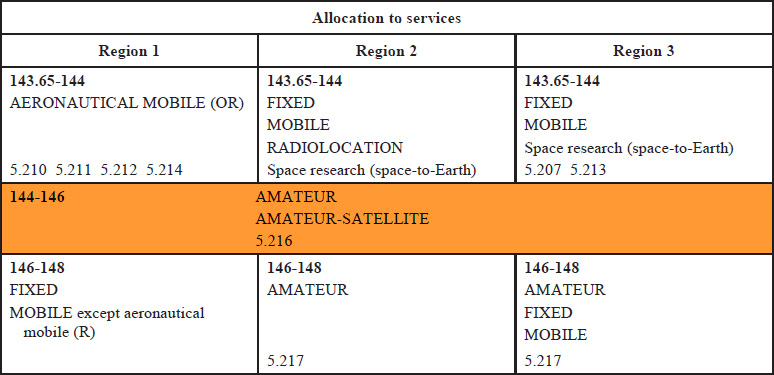
Wireless Waffle understands that the proposal was originated by French defence manufacturer Thales, and that their preferred outcome would be a co-primary allocation. Should this happen, notwithstanding the fact that there would be an interferer in the 2 metre band, the aeronautical services, if they suffered interference from amateurs, could them potential claim protection. It is not completely impossible that as a result of this, the amateur service could be either reduced to secondary status, or told to leave the band. Such an outcome would take at least 12 years, as it would first have to be put on the agenda for a future WRC (which could not be until at least 2027), then studied, before a decision could be made (at the eariest 2031).
Should radio amateurs be concerned. In a word, YES! The 2 metre band is very heavily used and is one of the only primary and exclusive amateur radio allocations that exists. A number of other amateur bands have recently been reduced or lost to other services (e.g. 2.3 GHz, 3.4 GHz) and there is also consideration of removing the amateur service from the 23cm band from 1260 to 1300 MHz to protect satellite navigation systems. However inconceivable it may be that the 2 metre band could go the same way, it is not impossible.
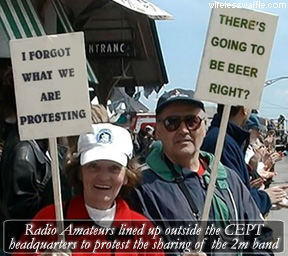 What can radio amateurs do? It is the national radio spectrum administrations who attends the CEPT/ECC meetings and represents the views of their country. In the first instance, therefore, amateurs should write to their national regulator (e.g. Ofcom in the UK) and express the importance of keeping the 2 metre band primary and exclusive for amateur use.
What can radio amateurs do? It is the national radio spectrum administrations who attends the CEPT/ECC meetings and represents the views of their country. In the first instance, therefore, amateurs should write to their national regulator (e.g. Ofcom in the UK) and express the importance of keeping the 2 metre band primary and exclusive for amateur use.
International organisations such as the IARU and national organisations such as the RSGB get involved to support the interests of radio amateurs, but this can only succeed if the national administrations listen empathetically.
If national administrations fail to support the amateur service, the next step would probably be for radio amateurs to protest outside CEPT/ECC meetings to try and demonstrate to CEPT just how strongly they object.
 A recent meeting of CEPT/ECC Working Group PT-A which took place in June in Prague, Czechia, was considering the items that should go on the agenda of the 2023 WRC, as these need to be agreed at the 2019 WRC to be held later this year. At this meeting, the French spectrum regulator, the ANFR, updated a proposal concerning:
A recent meeting of CEPT/ECC Working Group PT-A which took place in June in Prague, Czechia, was considering the items that should go on the agenda of the 2023 WRC, as these need to be agreed at the 2019 WRC to be held later this year. At this meeting, the French spectrum regulator, the ANFR, updated a proposal concerning:an agenda item for new non-safety aeronautical mobile applications.
Non-safety aeronautical mobile services are likely to consist of things such as the remote control of (military) drones. As a result of this submission, the meeting has proposed an item that will be taken by CEPT member countries to the next WRC which states:
New non-safety aeronautical mobile applications will support applications like: imagery, video, fire and border surveillance, environment monitoring, traffic/disaster monitoring. Such applications require ground to air, air to ground and air to air, communications on-board manned and unmanned aircraft. Use of innovative sharing methods may be considered to ensure the protection of existing services while offering the possibility to have access to new frequency bands. Several frequency bands are proposed for investigation within different ranges in order to meet the various operational requirements for new non-safety aeronautical mobile applications.
It is proposed to study the bands 162.0375-174.000 MHz, 862-874 MHz and 22-22.21 GHz in order to evaluate the possible revision or deletion of the "except aeronautical mobile" restriction and the bands 144-146 MHz, 5000-5010 MHz and 15.4-15.7 GHz for possible new allocations to the aeronautical mobile service.
 Hidden amongst this is a potential time-bomb for radio amateurs. The French administration is effectively proposing that the 2 metre amateur band (144 - 146 MHz) which is currently allocated for the exclusive use by radio amateurs, should be shared with non-safety aeronautical mobile services. Note that this is already the case in China and that in Region 1 (Europe) the spectrum immediately below the 144 MHz band is already allocate for Aeronautical Mobile services. The proposal does not state whether the new allocation should be on a secondary basis (in which case radio amateurs would continue to be protected from interference) or whether it would be on a co-primary basis (in which case both sets of users would have equivalent interference protection rights).
Hidden amongst this is a potential time-bomb for radio amateurs. The French administration is effectively proposing that the 2 metre amateur band (144 - 146 MHz) which is currently allocated for the exclusive use by radio amateurs, should be shared with non-safety aeronautical mobile services. Note that this is already the case in China and that in Region 1 (Europe) the spectrum immediately below the 144 MHz band is already allocate for Aeronautical Mobile services. The proposal does not state whether the new allocation should be on a secondary basis (in which case radio amateurs would continue to be protected from interference) or whether it would be on a co-primary basis (in which case both sets of users would have equivalent interference protection rights).
Wireless Waffle understands that the proposal was originated by French defence manufacturer Thales, and that their preferred outcome would be a co-primary allocation. Should this happen, notwithstanding the fact that there would be an interferer in the 2 metre band, the aeronautical services, if they suffered interference from amateurs, could them potential claim protection. It is not completely impossible that as a result of this, the amateur service could be either reduced to secondary status, or told to leave the band. Such an outcome would take at least 12 years, as it would first have to be put on the agenda for a future WRC (which could not be until at least 2027), then studied, before a decision could be made (at the eariest 2031).
Should radio amateurs be concerned. In a word, YES! The 2 metre band is very heavily used and is one of the only primary and exclusive amateur radio allocations that exists. A number of other amateur bands have recently been reduced or lost to other services (e.g. 2.3 GHz, 3.4 GHz) and there is also consideration of removing the amateur service from the 23cm band from 1260 to 1300 MHz to protect satellite navigation systems. However inconceivable it may be that the 2 metre band could go the same way, it is not impossible.
 What can radio amateurs do? It is the national radio spectrum administrations who attends the CEPT/ECC meetings and represents the views of their country. In the first instance, therefore, amateurs should write to their national regulator (e.g. Ofcom in the UK) and express the importance of keeping the 2 metre band primary and exclusive for amateur use.
What can radio amateurs do? It is the national radio spectrum administrations who attends the CEPT/ECC meetings and represents the views of their country. In the first instance, therefore, amateurs should write to their national regulator (e.g. Ofcom in the UK) and express the importance of keeping the 2 metre band primary and exclusive for amateur use. International organisations such as the IARU and national organisations such as the RSGB get involved to support the interests of radio amateurs, but this can only succeed if the national administrations listen empathetically.
If national administrations fail to support the amateur service, the next step would probably be for radio amateurs to protest outside CEPT/ECC meetings to try and demonstrate to CEPT just how strongly they object.

